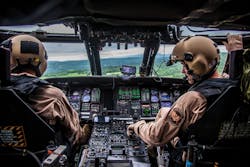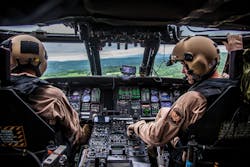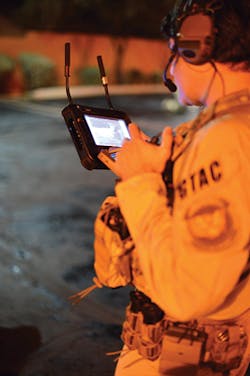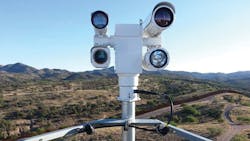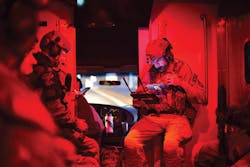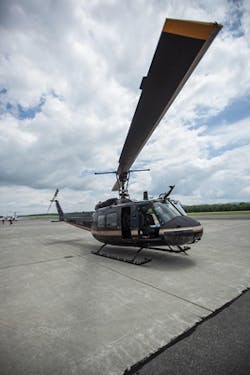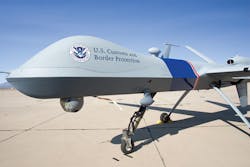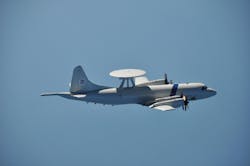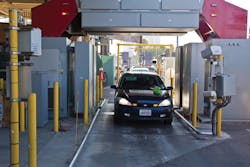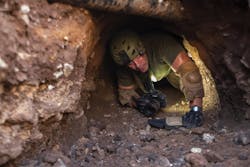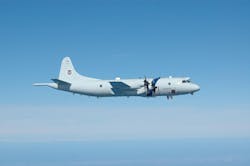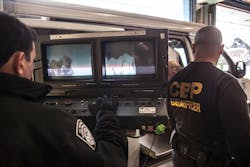The role of technology in securing the nation’s borders
The U.S. Department of Homeland Security relies on a variety of electro-optical cameras, lasers, chemical detectors, X-rays, and other sensors to limit entry of illegal immigrants, drugs, and other contraband. By J.R. Wilson
U.S. border security and immigration control is one of the hottest — and most divisive — political topics in America today. Yet technology, not politics, is one of the most important topics for those tasked with securing the borders, countering the influx of illegal drugs and other contraband, and containing a flood of people from all over the world. Autorities must defend the long and largely isolated northern and southern land borders, thousands of miles of coastline, and the nation’s vast airspace.
The days of monitoring these areas by human eyes alone, attempting to use sometimes-out-of-date paper to identify repeat offenders and known criminals, are over (although still a vital part of the effort). Today, the nation’s borders and coastlines are under constant surveillance from satellites and sensor-packed unmanned aerial vehicles (UAVs), aerostats, manned aircraft, boats, and ground vehicles.
Customs and Border Patrol agents use the Sikorsky UH-60 Black Hawk helicopter, developed originally for the U.S. military, for border surveillance and interdiction.
The fast-growing need for interdiction, the large variety of sensors and platforms now being used or planned for in the future, and the dozens of local, state, and federal agencies involved also has increased the need for shared intelligence at all levels through real-time networks, advanced communications systems, and artificial intelligence (AI). The technologies employed and being developed vary from agency to agency, depending on the task for which each is responsible.
The U.S. Coast Guard research center in New London, Conn., is one of the smallest of the armed services labs, focusing its limited budget on adapting existing sensor technologies, non- and less-than-lethal technologies, unmanned and autonomous systems, and operations research modeling and simulation — all to develop and support better patrol tactics to deploy to the field.
“As part of the intel community, we aren’t just focused on the ops side — interdicting and countering contraband — but tying things together with intel,” explains Bert Macesker, executive director of the Coast Guard research center. “That’s a lot of the guiding principal for some of the smuggling technologies we’re investigating. Combating networks, securing borders, and safeguarding commerce are three pillars that guide a lot of the tech we’re looking at, focusing more on the higher-end technologies and introducing that to the Coast Guard.
Border patrol agents are adopting a variety of wearable and handheld computers and sensors to help secure U.S. borders.
Laser technology
Laser technology is one Coast Guard focus when it comes to border security. “We’re looking in the field at the Coast Guard-Hailing Acoustic Laser-Light Tactical,” Macesker says. “CG-HALLTS sits on a tripod, but will be integrated onto the top of the bridge on smaller cutters. It includes a long-range acoustic device, with very focused acoustic capabilities, so you can talk to someone from long distances and issue commands to suspect vessels. It also has a laser system to get attention, somewhat like an eye-safe laser dazzler, so we can use it in a port environment, which was part of the challenge to get approval for it. Those can be operated separately or together, from a small boat, or remote-controlled from the bridge of a fast response cutter.”
Originally developed for the U.S. Navy, the Coast Guard’s unique missions require some significant modifications to HALLTS, such as the long-range acoustic device directional speaker, capable of projecting a warning tone for nearly two miles; a Maxa Beam searchlight with a 12 million-candlepower peak beam, and an eye-safe Class 2 Glare Helios dazzling laser.
The Coast Guard has the widest area of responsibility for border security of any U.S. agency, starting with 100,000 miles of coastline and inland waterways. It also safeguards an Exclusive Economic Zone (EEZ) encompassing 4.5 million square miles, stretching from north of the Arctic Circle to south of the Equator, from Puerto Rico to Guam, encompassing nine time zones — the largest EEZ in the world. In addition, Coast Guard District 14 alone covers more than 12 million square miles in the remote Pacific, including the maritime boundaries of four independent Pacific island countries that lie within their area of responsibility.
A cornerstone of U.S. border security technology involves electro-optical devices like visible-light cameras and infrared sensors to detect illegal border crossings.
As the smallest of the uniformed services — fewer personnel than the New York City Police Department — the Coast Guard has come to see the rapid evolution of technology as essential to keeping up with, if not ahead of, drug cartels, terrorist organizations, and other elements of organized crime that sometimes have more money and more advanced technologies.
They are not, however, the only guardians of America’s borders. That task is shared with Customs and Border Protection (CBP), Immigration & Customs Enforcement (ICE), Border Patrol Air & Marine Operations (AMO) — all, including the Coast Guard, part of the Department of Homeland Security.
Homeland security programs
Even a partial list of technology programs within DHS, the nation’s largest cabinet-level department, is extensive and indicative of how far-reaching the search for technological advantage has grown. The search includes:
- air-based technologies;
- apex border situational awareness;
- Arctic communications and technologies;
- biometric technology engine;
- Canada-U.S. Enhanced Resiliency Experiment (CAUSE);
- countering violent extremism — actionable indicators and countermeasures project;
- data analytics engine;
- eye-dentify;
- Future Attribute Screening Technology (FAST);
- ground-based technologies;
- identity and access management engine;
- low-light internet protocol camera;
- Pat-Down Accuracy Training Tool (PATT);
- Polar Scout;
- space-based sensors;
- port of entry-based technology;
- port and waterway resiliency;
- port of entry people screening;
- port and coastal surveillance;
- port of entry forensics and investigations;
- Post Tracking System (PTS);
- small dark aircraft, or the hunt for drug-smuggling aircraft at the borders;
- tunnel detection and surveillance;
- video-based training for border patrol trackers; and
- virtual shooter
For the Coast Guard, whose boats, aircraft, and personnel are lightly armed, the goal is to get a suspect or platform to stop, using technologies such as CG-HALLTS to do that at some distance.
“Our small-boat operators don’t have a lot of time to escalate force. We’re trying not to use lethal capabilities, so we have researched and developed various entanglement systems that can be shot from a helicopter or from special guns on our patrol boats. We also use pepper balls shot from a paint gun. But the bad guys are always coming up with ways to combat those things, so we have to keep working on what’s next,” Macesker explains.
Border surveillance experts use some of the latest commercial-off-the-shelf computers and communications devices in border patrol and search-and-rescue operations.
Nonlethal technology
“We’ve been looking at less-than-lethal RF technology, which DOD is investing a lot of money in; the technology isn’t quite ready for the Coast Guard, so we’re waiting to see how it develops with the Navy,” Macesker says. “We’re looking at technology for improved communications and to improve or strengthen our ability to intercept non-compliant vessels. Some future game-changers, which are already taking place in some cases, include machine learning to make good use of intel. But the challenge is to get things out rapidly into the hands of operators in the field.”
AMO covers much of the same territory as the Coast Guard, but by air rather than the predominantly water-based Coast Guard. Their fleet of 240 aircraft and nearly 600 pilots flies an average of more than 200 hours a day in air-to-air, air-to-water and air-to-ground border interdiction missions, patrolling oceans, lakes, and rivers to prevent the illegal entry of undocumented aliens, weapons of terror, and illegal narcotics.
U.S. Customs and Border Protection uses the Bell UH-1 helicopter, among other aircraft, to maintain surveillance on U.S. borders.
AMO’s recently released Vision 2025, the first official documentation of the organization’s role in securing the homeland, established its approach to meeting the challenges of securing a 21st Century border using advanced aeronautical and maritime technologies. One of those is the Customs and Border Protection Air and Marine Operations Surveillance System (CBP AMOSS), which provides real-time air and maritime surveillance of U.S. borders and portions of the Western Hemisphere.
Another is the Coastal Interceptor Vessel SAFE Boat, a 41-foot, 10-ton boat equipped with four 350-horsepower Mercury outboard engines that provide a cruising speed of 58 knots across its 350-nautical-mile range. Using the new vessel’s radar and electro-optical infrared sensors, the three-man crew will work with AMO aircraft and other federal, state, and local law-enforcement agencies.
The U.S. Department of Homeland Security’s Bureau of Customs and Border Protection is capitalizing on military technology like the MQ-9 Reaper unmanned aircraft, shown above.
AMO also has issued a request for information (RFI) for a new Riverine Surface Patrol Platform (RSPP), to expand the capabilities of Border Patrol agents operating in the Rio Grande Valley. The current airboats operate in shallow to moderately deep waters and from soft river bed to rocky substrate; the RSPP would extend that to areas of river covered with weeds, grass and mud. It will have seating for five Border Patrol agents, other law enforcement officers, cargo, equipment, detainees or other individuals, and will be able to tow law enforcement or detained boats.
Biometrics
The rapidly advancing technologies of biometrics already are finding new applications in border security and immigration control missions. For example, facial recognition software led to the arrest of two imposters in separate incidents at Washington Dulles International Airport in Northern Virginia this summer, alerting federal agents that the two were using false passports to enter the country illegally. The software, also being tested at 14 other airports around the nation, compares a picture of a traveler with a database of passport and visa pictures belonging to people flying that day and flags those that do not match.
Federal officials recently announced plans to expand their biometric-based entry and exit system to include vehicles at land ports of entry. Customs and Border Protection, which is testing and evaluating several technological and operational changes to improve the accuracy and speed of biometric collection, will handle the new system. Officials say this should decrease ports of entry and exit wait times by improving the information resources available to immigration and border management personnel.
Small tactical UAVs like the RQ-7B Shadow are in use by border security authorities.
“These biometrics may include digital fingerprint scans, facial images, iris images or other biometrics,” according to a Customs and Border Protection statement. “Biometrics may be collected from travelers entering or exiting the United States. Customs and Border Protection will store and use biometric data from those aliens specified in 8 CFR 215.8 and 8 CFR 235.1 to verify identity, determine admissibility of those seeking entry into the United States, confirm exit from the United States, track aliens who have overstayed their visas or are otherwise illegally present in the United States, prevent visa fraud, and identify known or suspected criminals or terrorists.”
Federal officials already have dozens of such screening terminals at detention centers to collect biometric data — fingerprints, iris scans, identifying features like scars and tattoos — from thousands of immigrants, mostly Central Americans arrested in Mexico. The department plans to expand the program in Mexico later this year and is negotiating similar efforts with the nations of Central America.
The long borders between the U.S., Canada, and Mexico require automated border surveillance with a variety of electro-optical equipment.
Meanwhile, scientists at the U.S. Army Research Laboratory have developed a method, using machine learning and artificial intelligence, to compare a thermal image of a person’s face with existing visual images. That would enable facial recognition in low-light environments or at night.
Small boat threat
New technologies also are being researched and applied by AMO and the Coast Guard, to deal with small boat threats. Small vessels include commercial fishing vessels, recreational boats and yachts, towing vessels, uninspected passenger vessels, or any other small commercial vessels involved in foreign or U.S. voyages.
U.S. border agents use sophisticated airborne sensor platforms like the P-3 Orion aircraft to keep tabs on border and maritime areas. This plane is based on a legacy U.S. Navy anti-submarine warfare aircraft.
According to DHS, security risks for small vessels can be broken down into four general categories:
- weapons smuggling;
- boat bombs;
- terrorist smuggling; and
- missile launchers.
AMO, Customs and Border Protection, and the Coast Guard also are expanding their use of UAVs to help manned helicopters and fixed-wing aircraft. The UAVs offer several advantages over manned platforms. Most don’t need to operate from airfields; some have greater endurance; they are less expensive; and they are more difficult for smugglers to see and avoid.
UAVs also can reach remote areas more quickly than boats and ground vehicles, and provide persistent, tactical airborne intelligence, surveillance and reconnaissance (ISR) capabilities to increase the effectiveness of patrol boats, national security cutters, and agents in the field.
A wide variety of car-scanning sensors are in use on the U.S. border crossing at San Ysidro, Calif., to detect illegal drugs, explosives, and other kinds of contraband.
Customs and Border Protection UAVs now provide aerial ISR along the entire Southwestern border, significantly enhancing the ground efforts of some 18,500 Border Patrol agents — more than twice the number working the area in 2001. To the north, UAVs patrol some 950 miles of remote border with Canada between Washington and Minnesota and another 200 miles across New York and Lake Ontario. Since 9/11, the number of Border Patrol agents on the Northern border has increased by 500 percent, to 2,200, while another 3,700 Customs and Border Protection officers manage the flow of people and goods. The actual security those agents provide is further multiplied by the application of various new and evolving technologies.
“We’ve been doing a lot with small UAV packages, which will be a game-changer in the future. Sensors are getting smaller and smaller; we have a test facility at Cape Cod looking at a direction-finding mini-SAR [synthetic aperture radar] for Pumas, for example. The Coast Guard has mid-size UAVs on the National Security Cutters, which are catapult-launched and have a lot of endurance, but there is opportunity for even smaller UAVs,” Macesker says.
“That also applies to unmanned surface vessels [USVs]. There is a lot of potential there. We recently used an unmanned rigid-hull inflatable boat the Navy is using for counter-mine detection, evaluating it against several counter-drug vignettes. All those things are coming, but a lot of it is a challenge in overcoming policies and regulations within the government.”
Border Patrol agents must deal with tunnels crossing the U.S. border, which makes development of underground sensors and communications a top priority.
The United States is one of the most vulnerable nations on Earth in terms of securing its borders against all forms of smuggling and ensuring those entering the country do so legally and are fully vetted as to identity, criminal history and ties to terrorist groups. The DHS Science and Technology Directorate (S&T) works closely with industry, Pentagon labs, and individual agency research centers to develop or adapt technology and knowledge products to detect, interdict, and prosecute illegal activities along borders and ports of entry.
This Customs and Border Patrol P-3 surveillance aircraft can detect and track several different targets simultaneously to enable accompanying aircraft and boats to interdict illegal border traffic.
Border security initiatives
The scope and diversity of challenges of border security and immigration control can be seen in some of the programs DHS science and technology currently is pursuing or has deployed:
- the Border Research in Instrumented Construction Project identifies cameras, sensors, and other technology that can be applied on or near a smart wall via ground, surface, air, subsurface, and water to enhance border security and agent safety;
- the Apex Border Situational Awareness program helps Customs and Border Protection access data sources, develop decision support tools, and share information with partner law enforcement agencies to improve situational awareness;
- Integrated Maritime Domain Enterprise a platform bridging disparate data systems to make it easier for DHS components to share information and collaborate;
- the Adaptive Sensor Analytics Project (ASAP) provides automated data analytics to process satellite imagery, identify patterns of criminal activity and alert DHS officials;
- Ground-Based Technologies Program — improves the ability to detect illegal activity at the border through stronger situational awareness, automated detection and alerts, target classification, and tools to promote agent safety;
- Air-Based Technologies Program — identifies, tests and evaluates unmanned and manned aircraft and sensors for law enforcement, search-and-rescue, and disaster response in land and maritime environments;
- Expert Tracker training program — helps Border Patrol agents improve their ability to track movement in rough terrain along the nation’s borders;
- Port of Entry-Based Technology Program — a multi-year effort to improve illicit cargo detection and legitimate cargo throughput by upgrading legacy scanning systems, linking them to new analysis and information sharing tools that make the most of personnel resources and state-of-the-art technology to enhance the detection performance of cargo scanning systems and extend their service life;
- Port of Entry People Screening Program — identifies, evaluates and implements combinations of process and technology improvements to facilitate the movement of people through the nation’s air, land and sea ports of entry;
- Autopsy is an open-source digital forensics platform that helps law enforcement determine how electronic devices were used in a crime and recover evidence;
- Child Exploitation Image Analytics (CHEXIA) — reduces the amount of time it takes to identify and rescue children from exploitation, as well as identify perpetrators, through automated face recognition algorithms and forensic tools;
- Tunnel Detection and Surveillance Program — helps border officials detect and locate clandestine tunnels, as well as gather forensic data to support investigation and prosecution of drug smuggling activities;
- Port of Entry Forensics and Investigations Program — helps combat transnational crime and investigate child exploitation and human trafficking through open-source data and forensic analysis of material collected from suspicious packages and cargo;
- Common Viewer Workstation — develops a common scanning workstation with a common graphical user interface with stationary and mobile non-intrusive inspection systems; develops a wireless communications infrastructure to support data-sharing, workload-sharing, and rapid information exchange; and develops threat-detection algorithms for contraband;
- Improve Performance of NII Detectors and/or Sources — improves the performance of non-intrusive inspection systems to increase Customs and Border Protection’s ability to interdict contraband without slowing commerce through advanced data analytics and system architecture, automated threat recognition, advanced imaging systems and standardized NII metrics;
- Integrated Fixed Tower (IFT) systems — provide Border Patrol with long-range, persistent surveillance along the Arizona/Mexico border, automatically using radars to identify and classify items of interest with day/night cameras and tracking items of interest at the Command and Control Center using a COP that integrates data, video and geospatial locations;
- Remote Video Surveillance Systems (RVSS) — a fixed technology used by Border Patrol in select areas along the Southwest and Northern borders, providing short-, medium- and long-range persistent surveillance from towers or other structures. RVSS uses cameras, radio and microwave transmitters to send video to a control room operator to remotely detect, identify, classify and track targets.
- Unattended Ground Sensors (UGS) — seismic, passive infrared, acoustic, contact closure, and magnetic sensors providing short-range persistent surveillance to support detection and, to a limited extent, track and identify subjects;
- Mobile Surveillance Capability (MSC) systems — Border Patrol vehicle-mounted radars and camera sensors for long-range mobile surveillance, automatic detection and and tracking of items of interest while providing the agent/operator with data and video of the observed subject;
- Mobile Vehicle Surveillance Systems (MVSS) — short- and medium-range mobile surveillance cameras on telescoping masts mounted on Border Patrol vehicles to detect, track, identify, and classify items of interest and assist agents responding to any intrusions;
- Agent Portable Surveillance System (APSS) — a tripod-mounted medium-range mobile surveillance system used by teams of two or three Border Patrol agents to automatically detect, track and record items of interest;
- Customs and Border Protection’s Tactical Aerostats and Re-locatable Towers program — a mix of aerostats, towers, cameras, and radars providing agents with increased wide-area situational awareness. Since initial deployment in 2012, they have detected more than 180,000 illegal border incursions of aliens and smugglers, leading to the seizure of approximately 180 tons of narcotics and related contraband; and
- AMO’s Tethered Aerostat Radar System (TARS) — monitors low-altitude aerial approaches to the United States from eight sites — six along the Southwest border, one in the Florida Keys, and one in Puerto Rico. The elevated TARS sensor provides over-the-horizon coverage. From 2014 through 2016, TARS was responsible for detecting 86 percent of all suspected air smuggling flights approaching the Southwest border from Mexico.
Underwater imaging
“We’ve been evaluating an underwater imaging system to track parasitic attachments to vessels seeking entry to ports using high-definition, high-resolution underwater acoustic capability,” Macesker says. “To counter contraband smuggling on the Northern borders and Great Lakes, we are looking at unmanned systems, including tethered balloons that could carry small infrared sensors. The smaller sensor payloads get, the more accessible they become and you will see more of these systems out there, especially as the price point comes down.
Customs and Border Protection agents use X-ray scanners to screen vehicles for people and contraband crossing U.S. borders.
“We’re also trying to take advantage of the new generation of small pico-sats. We’re getting ready for a SpaceX launch of a couple of cubesats with programmable radios on board, sometime in October. They will go into a polar orbit and we’ll evaluate their capability to monitor distress beacons, so it will have a search and-rescue] focus. We built a ground control station in Fairbanks and will build another with a dome and tracking radar at the Coast Guard Academy. That will be our first real foray into the space environment with our own cubesats, which are much more affordable. We do have other assets for SAR and so forth, but this is our first look at really low-cost micro-sats, which also can be communications relays or have other applications. as border security].”
